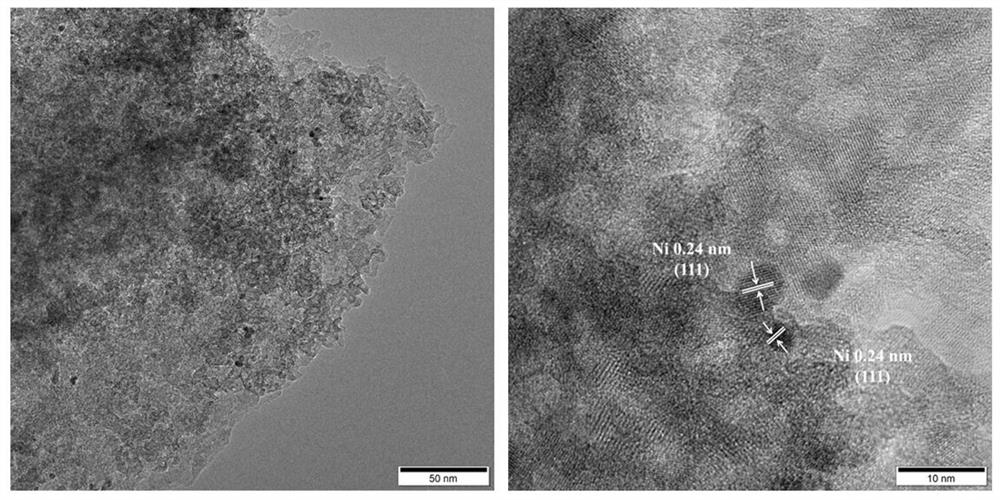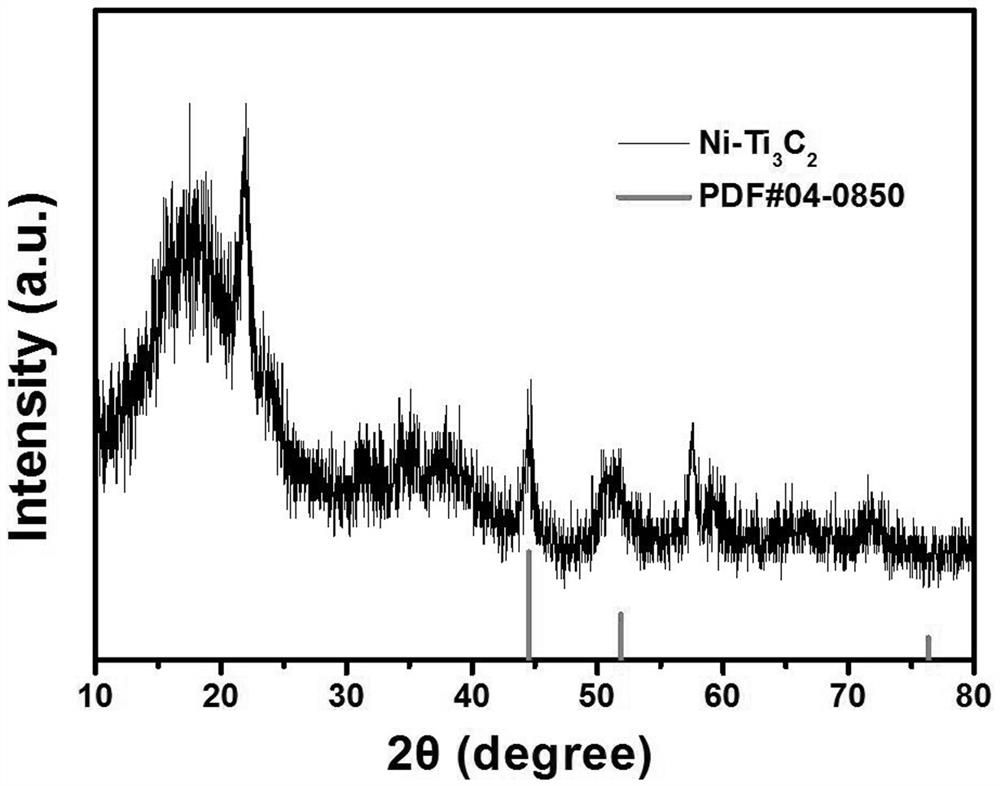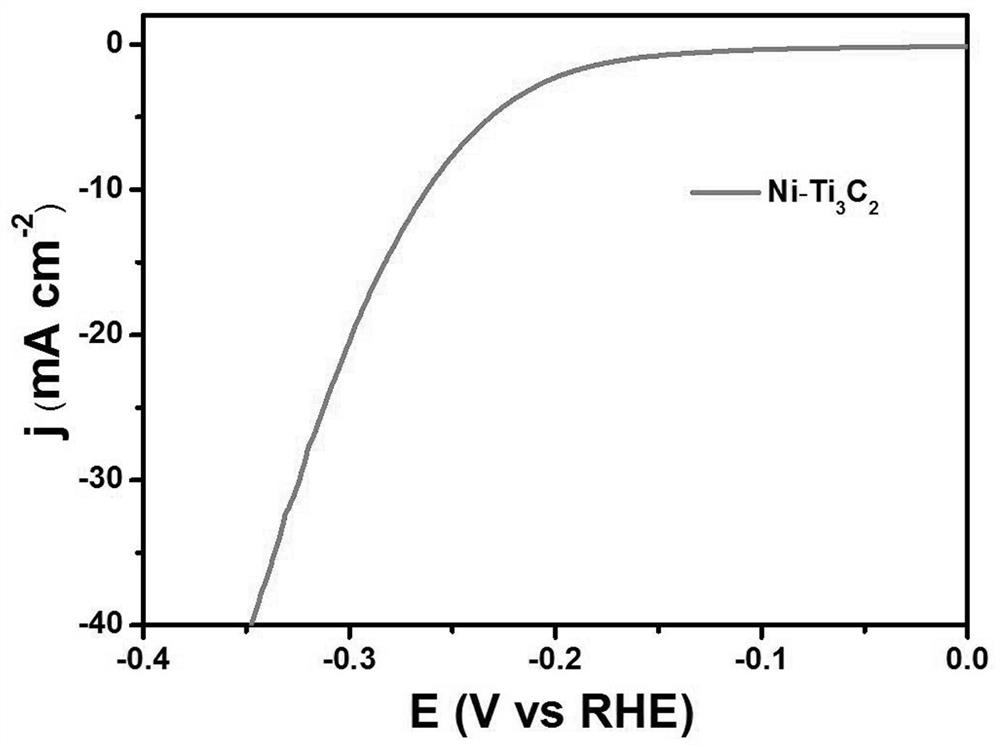Method for preparing Ni-Ti3C2 composite electrocatalyst by hydrothermal method
A technology of electrocatalyst and hydrothermal method, which is applied in the direction of electrodes, electrolysis process, electrolysis components, etc., can solve the problems of poor oxidation resistance, surface catalytic activity and loss of electronic characteristics, etc., to achieve increased contact area, excellent catalytic hydrogen evolution performance, The effect of fast reaction rate
- Summary
- Abstract
- Description
- Claims
- Application Information
AI Technical Summary
Problems solved by technology
Method used
Image
Examples
Embodiment 1
[0027] Preparation of Ni-Ti by a hydrothermal method 3 C 2 The method for composite electrocatalyst, concrete steps are as follows:
[0028] 1. Take 20 mg Ti 3 C 2 The nanosheets were dispersed into 20 mL of water, and the first homogeneous mixed solution was obtained by ultrasonic treatment; among them, Ti 3 C 2 by Ti 3 AlC 2 The powder was treated with 9 M hydrochloric acid at 35 °C for 48 h, then washed with deionized water to pH 6, and then sonicated at 300 W for 2 h.
[0029] 2. Disperse 237.9 mg of nickel chloride hexahydrate into 10 mL of water, and perform ultrasonic treatment to obtain a uniform second mixed solution;
[0030] 3. Take 176 mg of ascorbic acid and disperse it in 10 mL of water, and perform ultrasonic treatment to obtain a uniform third mixed solution;
[0031] 4. Transfer the first mixed solution to a 100 ml high-temperature and high-pressure reactor. The inner wall of the high-temperature and high-pressure reactor is equipped with a polytetrafl...
Embodiment 2
[0042] Preparation of Ni-Ti by a hydrothermal method 3 C 2 The method for composite electrocatalyst, concrete steps are as follows:
[0043] 1. Take 20 mg Ti 3 C 2 The nanosheets were dispersed into 50 mL of water, and the first mixed solution was obtained by ultrasonic treatment; among them, Ti 3 C 2 by Ti 3 AlC 2 The powder was treated with 9 M hydrochloric acid at 35 °C for 48 h, then washed with deionized water to pH 6, and then sonicated at 300 W for 2 h.
[0044] 2. Disperse 237.9 mg of nickel chloride hexahydrate into 30 mL of water, and perform ultrasonic treatment to obtain a uniform second mixed solution;
[0045] 3. Take 176 mg of ascorbic acid and disperse it into 30 mL of water, and perform ultrasonic treatment to obtain a uniform third mixed solution;
[0046] 4. Transfer the first mixed solution to a 100 ml high-temperature and high-pressure reactor. The inner wall of the high-temperature and high-pressure reactor is equipped with a polytetrafluoroethyle...
Embodiment 3
[0052] Preparation of Ni-Ti by a hydrothermal method 3 C 2 The method for composite electrocatalyst, concrete steps are as follows:
[0053] 1. Take 20 mg Ti 3 C 2 The nanosheets were dispersed into 30 mL of water, and the first mixed solution was obtained by ultrasonic treatment; among them, Ti 3 C 2 by Ti 3 AlC 2 The powder was treated with 9 M hydrochloric acid at 35 °C for 48 h, then washed with deionized water to pH 6, and then sonicated at 300 W for 2 h.
[0054] 2. Disperse 237.9 mg of nickel chloride hexahydrate into 20 mL of water, and perform ultrasonic treatment to obtain a uniform second mixed solution;
[0055] 3. Take 176 mg of ascorbic acid and disperse it into 20 mL of water, and perform ultrasonic treatment to obtain a uniform third mixed solution;
[0056] 4. Transfer the first mixed solution to a 100 ml high-temperature and high-pressure reactor. The inner wall of the high-temperature and high-pressure reactor is equipped with a polytetrafluoroethyle...
PUM
 Login to View More
Login to View More Abstract
Description
Claims
Application Information
 Login to View More
Login to View More - R&D Engineer
- R&D Manager
- IP Professional
- Industry Leading Data Capabilities
- Powerful AI technology
- Patent DNA Extraction
Browse by: Latest US Patents, China's latest patents, Technical Efficacy Thesaurus, Application Domain, Technology Topic, Popular Technical Reports.
© 2024 PatSnap. All rights reserved.Legal|Privacy policy|Modern Slavery Act Transparency Statement|Sitemap|About US| Contact US: help@patsnap.com










